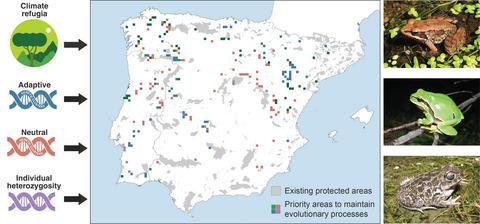当前位置:
X-MOL 学术
›
J. Appl. Ecol.
›
论文详情
Our official English website, www.x-mol.net, welcomes your
feedback! (Note: you will need to create a separate account there.)
Conservation planning for adaptive and neutral evolutionary processes
Journal of Applied Ecology ( IF 5.0 ) Pub Date : 2020-07-24 , DOI: 10.1111/1365-2664.13718 Jeffrey O. Hanson 1 , Adam Marques 1 , Ana Veríssimo 1 , Miguel Camacho‐Sanchez 1 , Guillermo Velo‐Antón 1 , Íñigo Martínez‐Solano 1, 2 , Silvia B. Carvalho 1
中文翻译:

适应性和中性进化过程的保护规划
更新日期:2020-07-24
Journal of Applied Ecology ( IF 5.0 ) Pub Date : 2020-07-24 , DOI: 10.1111/1365-2664.13718 Jeffrey O. Hanson 1 , Adam Marques 1 , Ana Veríssimo 1 , Miguel Camacho‐Sanchez 1 , Guillermo Velo‐Antón 1 , Íñigo Martínez‐Solano 1, 2 , Silvia B. Carvalho 1
Affiliation

|
- Protected area systems should ideally maintain adaptive and neutral evolutionary processes. To achieve this, plans for expanding protected area systems (prioritizations) can improve coverage of related attributes (evolutionary attributes). However, long‐standing challenges in mapping and operationalizing evolutionary attributes have prevented their widespread usage.
- We outline a novel framework for incorporating evolutionary processes into conservation planning. Using three amphibian species in the Iberian Peninsula (Hyla molleri, Pelobates cultripes and Rana iberica), we mapped a comprehensive range of adaptive and neutral evolutionary attributes to delineate places containing individuals with moderate to high heterozygosity, different neutral genetic clusters, different adaptive genetic clusters and climatic refugia. We overlaid these maps with boundaries of existing protected areas to quantify representation shortfalls and generated a prioritization to identify additional priority areas. To assess the performance of conventional approaches, we also generated a prioritization using only the species' distribution data—without the evolutionary attributes.
- We found that existing protected areas within the Iberian Peninsula are failing to adequately represent evolutionary attributes for the study species. Specifically, they are not adequately representing places predicted to contain individuals with moderate to high heterozygosity for any of the studied species, and neither are they adequately representing the species' potential climatic refugia. They also have poor coverage of the distinct adaptive and neutral genetic clusters that comprise each of the species' distributions. By incorporating the evolutionary attributes into the prioritization process, we identified priority areas that would address all of the shortfalls for only a minor increase in the size of the protected area system. In comparison, the prioritization generated following conventional approaches, despite encompassing a similar extent, did not substantially improve representation of the species' evolutionary attributes.
- Synthesis and applications. We introduce a framework for incorporating adaptive and neutral evolutionary processes into conservation planning. This framework can reveal weaknesses in the coverage of climatic refugia, genetic diversity and potential local adaptations by existing protected areas. Moreover, it can identify priority areas to improve conservation of evolutionary processes. Since neglecting evolutionary processes can impair conservation plans, we recommend using evolutionary data to inform decision‐making where possible.
中文翻译:

适应性和中性进化过程的保护规划
- 保护区系统应该理想地保持适应性和中立的进化过程。为此,扩大保护区系统(优先级)的计划可以改善相关属性(进化属性)的覆盖范围。但是,在映射和操作进化属性方面的长期挑战阻止了它们的广泛使用。
- 我们概述了将进化过程纳入保护规划的新颖框架。在伊比利亚半岛(Hyla molleri,Pelobates cultripes和Rana iberica)使用两种两栖动物。),我们绘制了一系列全面的适应性和中性进化属性,以描绘包含中等至高度杂合性,不同中性遗传簇,不同适应性遗传簇和气候避难所的个体的场所。我们用现有保护区的边界覆盖了这些地图,以量化代表不足,并确定了优先级以识别其他优先区域。为了评估常规方法的性能,我们还仅使用物种的分布数据(没有进化属性)生成了优先级。
- 我们发现,伊比利亚半岛内现有的保护区未能充分代表研究物种的进化属性。具体而言,它们不足以代表所研究物种中预计具有中等至高度杂合性的个体的场所,也不能充分代表该物种的潜在气候避难所。他们对组成每个物种分布的独特的适应性和中性遗传簇的覆盖率也很差。通过将进化属性纳入优先级划分过程,我们确定了优先领域,该领域可以解决所有不足,而保护区系统的规模只会稍有增加。相比之下,按常规方法生成的优先级
- 综合与应用。我们介绍了将适应性和中性进化过程纳入保护规划的框架。该框架可以揭示现有保护区在气候避难所,遗传多样性和潜在的当地适应性方面的不足。而且,它可以确定优先领域以改善进化过程的保护。由于忽略进化过程会损害保护计划,因此我们建议在可能的情况下使用进化数据为决策提供依据。











































 京公网安备 11010802027423号
京公网安备 11010802027423号